

7 Hidden Art Secrets That Were Uncovered With Technology. Paintings by the masters da Vinci, Rembrandt, Goya, and Caravaggio are often accepted as absolute works.
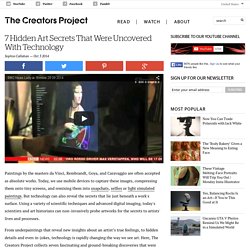
Today, we use mobile devices to capture these images, compressing them onto tiny screens, and remixing them into snapchats, selfies or light simulated paintings. But technology can also reveal the secrets that lie just beneath a work's surface. Using a variety of scientific techniques and advanced digital imaging, today's scientists and art historians can non-invasively probe artworks for the secrets to artists' lives and processes.
From underpaintings that reveal new insights about an artist’s true feelings, to hidden details and even in-jokes, technology is rapidly changing the way we see art. Here, The Creators Project collects seven fascinating and ground-breaking discoveries that were once shrouded from both art history and the visible world. A Set of Nameless Paints. The original presentation for “Nameless Paints” The names we assign to colors are restrictive and only serve to impede our minds.
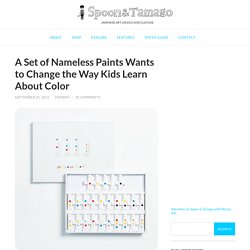
The water that comes out of a faucet isn’t “blue.” AOE Online Conference. The AOE Online Conference is a premier bi-annual (twice per year) online conference for Art Educators attended by thousands of art teachers from around the world.
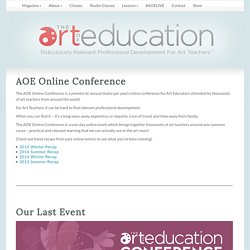
For Art Teachers, it can be hard to find relevant professional development. When you can find it – it’s a long ways away, expensive, or requires a ton of travel and time away from family. The AOE Online Conference is a one-day online event which brings together thousands of art teachers around one common cause – practical and relevant learning that we can actually use in the art room! Check out these recaps from past online events to see what you’ve been missing! 10 TED Talks Every Art Teacher Should Watch.
Hopefully, when I tell you I have been watching Ted Talks non-stop for a month, you know I am talking about the short, inspiring videos and not the rude, crude talking bear.

TED Talks started back in 1984 when a conference was held for Technology, Entertainment, and Design. Speakers were challenged to present powerful speeches in under 18 minutes. Since then, it has grown into a national movement with one mission– to spread ideas. My first TED talk happened to be by Matt Cutts with his challenge to do something new for 30 days. 11 Beautiful Oliver Sacks Quotes That Capture the Power of Music. Last Thursday, in a New York Times op-ed, neurologist and best-selling author Oliver Sacks revealed that he has been battling cancer in various forms for the past nine years and that it has now metastasized in his liver.
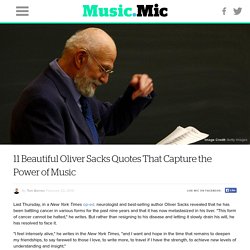
"This form of cancer cannot be halted," he writes. But rather than resigning to his disease and letting it slowly drain his will, he has resolved to face it. "I feel intensely alive," he writes in the New York Times, "and I want and hope in the time that remains to deepen my friendships, to say farewell to those I love, to write more, to travel if I have the strength, to achieve new levels of understanding and insight. " How Is Creativity Differentially Related to Schizophrenia and Autism? 24 2Share Synopsis Creative people have "messy minds".
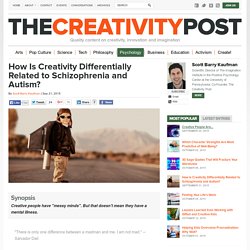
But that doesn't mean they have a mental illness. "There is only one difference between a madman and me. Artist Statement Guidelines — Getting Your Sh*t Together. Artists can send their artist statement for professional review.
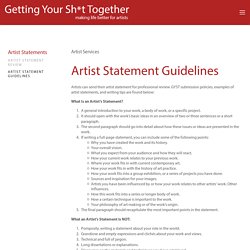
GYST submission policies, examples of artist statements, and writing tips are found below: What Is an Artist’s Statement? What an Artist’s Statement is NOT: Pomposity, writing a statement about your role in the world.Grandiose and empty expressions and clichés about your work and views.Technical and full of jargon.Long dissertations or explanations.Discourses on the materials and techniques you have employed.Poems or prosy writing.Folksy anecdotes about some important event in your life.Nothing about your childhood or family unless it is very relevant to your work.Not a brag fest or a press release.
Why Write an Artist’s Statement? Slow Looking and 5 Other Simple Activities to Enhance Your Students’ Ability to Analyze Art. With everything you have to fit into your curriculum, do you ever feel like some things just fall by the wayside?
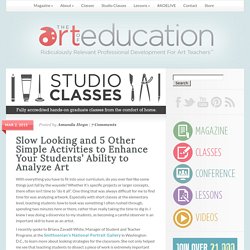
Whether it’s specific projects or larger concepts, there often isn’t time to “do it all”. One thing that was always difficult for me to find time for was analyzing artwork. Especially with short classes at the elementary level, teaching students how to look was something I often rushed through, spending two minutes here or there, rather than really taking the time to dig in. I knew I was doing a disservice to my students, as becoming a careful observer is an important skill to have as an artist. I recently spoke to Briana Zavadil White, Manager of Student and Teacher Programs at the Smithsonian’s National Portrait Gallery in Washington D.C., to learn more about looking strategies for the classroom. A Quick Guide of 20th Century Art Movements.